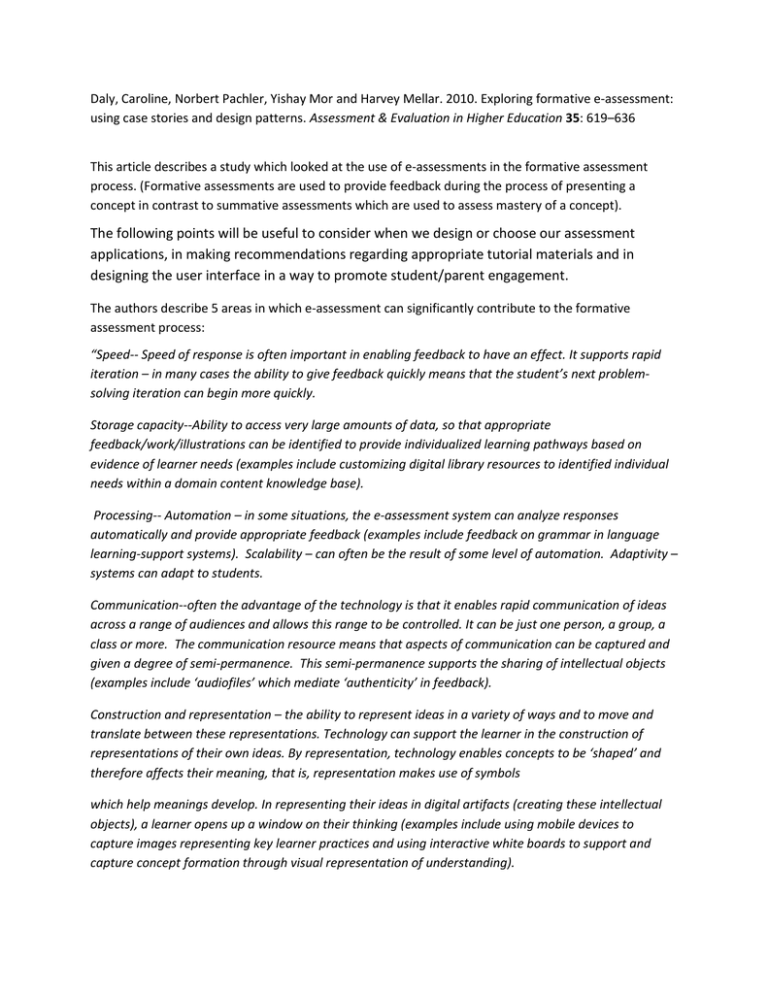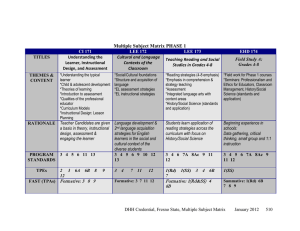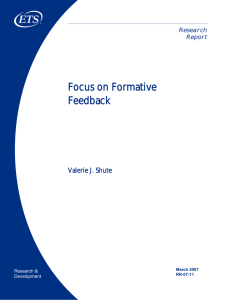Document 17838568
advertisement

Daly, Caroline, Norbert Pachler, Yishay Mor and Harvey Mellar. 2010. Exploring formative e-assessment: using case stories and design patterns. Assessment & Evaluation in Higher Education 35: 619–636 This article describes a study which looked at the use of e-assessments in the formative assessment process. (Formative assessments are used to provide feedback during the process of presenting a concept in contrast to summative assessments which are used to assess mastery of a concept). The following points will be useful to consider when we design or choose our assessment applications, in making recommendations regarding appropriate tutorial materials and in designing the user interface in a way to promote student/parent engagement. The authors describe 5 areas in which e-assessment can significantly contribute to the formative assessment process: “Speed-- Speed of response is often important in enabling feedback to have an effect. It supports rapid iteration – in many cases the ability to give feedback quickly means that the student’s next problemsolving iteration can begin more quickly. Storage capacity--Ability to access very large amounts of data, so that appropriate feedback/work/illustrations can be identified to provide individualized learning pathways based on evidence of learner needs (examples include customizing digital library resources to identified individual needs within a domain content knowledge base). Processing-- Automation – in some situations, the e-assessment system can analyze responses automatically and provide appropriate feedback (examples include feedback on grammar in language learning-support systems). Scalability – can often be the result of some level of automation. Adaptivity – systems can adapt to students. Communication--often the advantage of the technology is that it enables rapid communication of ideas across a range of audiences and allows this range to be controlled. It can be just one person, a group, a class or more. The communication resource means that aspects of communication can be captured and given a degree of semi-permanence. This semi-permanence supports the sharing of intellectual objects (examples include ‘audiofiles’ which mediate ‘authenticity’ in feedback). Construction and representation – the ability to represent ideas in a variety of ways and to move and translate between these representations. Technology can support the learner in the construction of representations of their own ideas. By representation, technology enables concepts to be ‘shaped’ and therefore affects their meaning, that is, representation makes use of symbols which help meanings develop. In representing their ideas in digital artifacts (creating these intellectual objects), a learner opens up a window on their thinking (examples include using mobile devices to capture images representing key learner practices and using interactive white boards to support and capture concept formation through visual representation of understanding). Mutability – shared objects are not fixed, they can change/be changed easily and quickly (examples include the use of a wiki to support building collaborative frameworks of ideas over time within critical audience conditions).” The authors also make the point that feedback in itself is not a guarantee that a student will benefit from a formative assessment. Several other factors are required including: “Engineering effective classroom discussion, questions and learning tasks that elicit evidence of learning; Providing feedback that moves learners forward; Clarifying, understanding and sharing learning intentions and criteria for success; Activating students as owners of their own learning; Activating students as instructional resources for one another.” Finally, a point that I have read before which is important to keep in mind in designing mentoring tool: “The degree of confidence that students have in the correctness of responses can affect receptivity to and seeking of feedback. Kulhavy and Stock (1989) noted that if confidence or response certainty is high and the response turns out to be a correct one, little attention is paid to the feedback. Feedback has its greatest effect when a learner expects a response to be correct and it turns out to be wrong. As Kulhavy and Stock noted, ‘high confidence errors are the point at which feedback should play its greatest corrective role, simply because the person studies the item longer in an attempt to correct the misconception’.”


